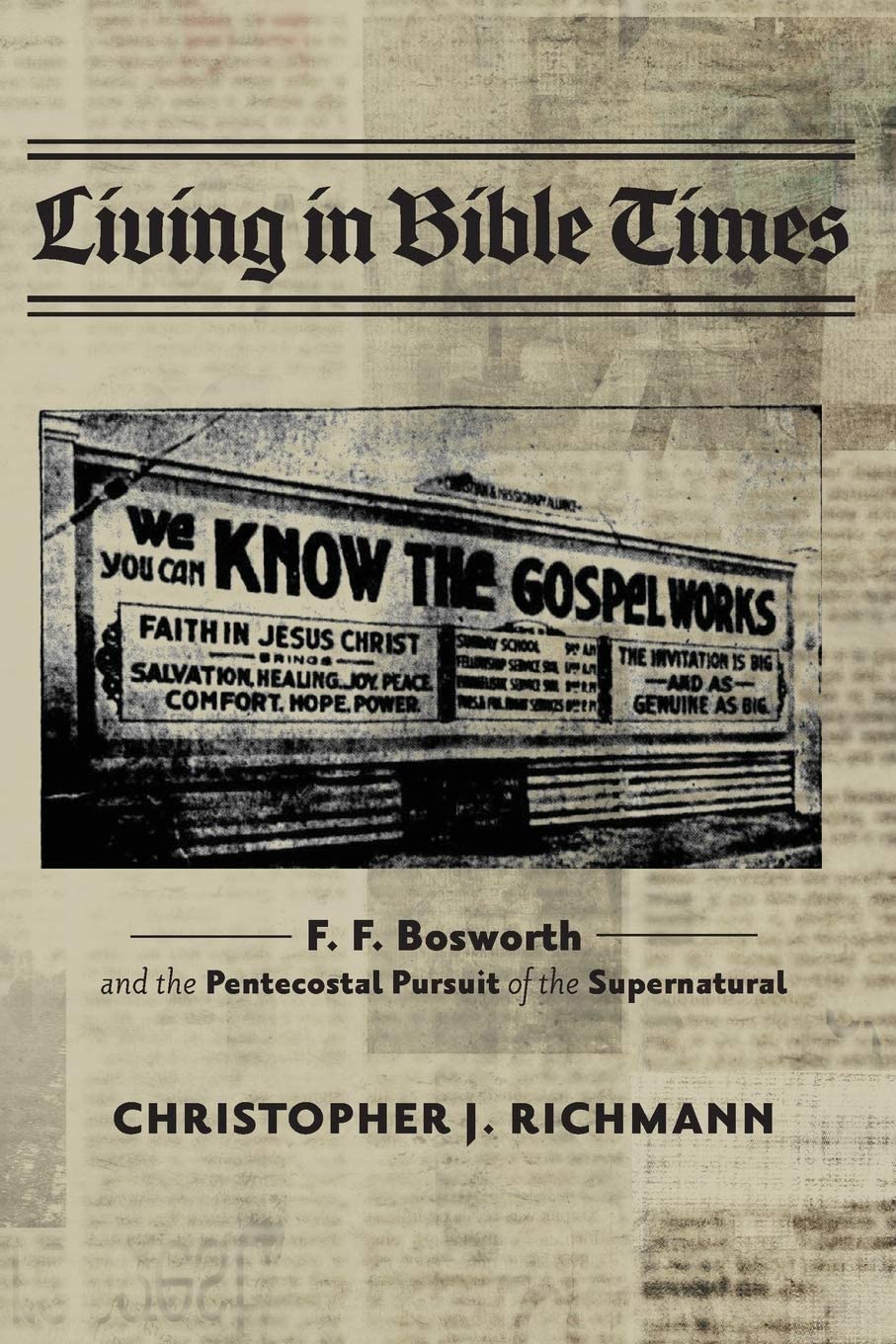Living in Bible Times: F.F. Bosworth and the Pentecostal Pursuit of the Supernatural by Christopher J. Richmann (Pickwick Publications, 2020)
Christopher J. Richmann has written a book on F.F. Bosworth and pentecostalism that far exceeds all previous research on the healing evangelist, who is widely known for his classic, Christ the Healer (1924). The book, which is titled, Living in Bible Times: F.F. Bosworth and the Pentecostal Pursuit of the Supernatural (Pickwick Publications, 2020), is a timely biography that shows in convincing terms how Bosworth played a major role in the Pentecostal movement of the early 1900s and later in the post-World War II healing revival. The 291-page volume is grounded in solid research that uses valuable documents, rarely seen reports, and an abundance of primary sources. In addition to tracking Bosworth’s life history, Richmann offers a fresh review of his contributions to Pentecostal church history.
As Richmann notes, Bosworth has not been given the attention that he deserves. “Scholars,” he writes, “have generally placed Bosworth on the periphery of the American pentecostal story.” That, however, is unfair when one considers Bosworth’s contributions. Richmann contends, and rightly so, that Bosworth should be viewed as a key figure in a movement that spanned many decades.
Richmann holds a Doctor of Philosophy degree from Baylor University. His book, Living in Bible Times, grew out of his doctoral research on Bosworth. Richmann is affiliate faculty in Religion and assistant director for the Academy for Teaching and Learning at Baylor University. He has published a number of articles on Bosworth and Pentecostalism. In addition to Pneuma, his work has appeared in the Journal of the European Pentecostal Association, the Lutheran Quarterly, and the Wesleyan Theological Journal.
In Living in Bible Times, Richmann challenges us to rethink the role of evidential tongues, the supernatural, divine healing, and the legacy of Azusa Street as denominational distinctives in Pentecostal church history. Specifically, he suggests the most dominant force in pentecostalism has been the pursuit of the supernatural, and it is this “pursuit” that he uses as a “guiding theme” to explain “Bosworth’s thought and impact on American religious history.”
For Richmann, the supernatural in his argument is the “perceptible manifestations of divine activity” that “require no sophisticated theological interpretation.” Richmann presents his research in eight chapters. In Chapter One, he discusses “The Gospel of the Supernatural.” It is here that he presents the roots of Bosworth’s religious development. He delves deeply into the history of the Methodist church and the holiness movement, as well as such topics as premillennialism and early pentecostalism. In Chapter Two, Richmann focuses on Bosworth as “A Pentecostal Leader-in-the-Making.” He tracks his life history from his birth in 1877 to 1906, the time when he lived in Zion City and received his own Pentecostal experience. It is in this section that Richmann accurately highlights Zion City as another critical site for the Pentecostal movement in the United States. Noting that Bosworth “had no substantial ties to Azusa Street,” he writes: “Consequently, links to Azusa Street are more limited in their historical importance than most historians acknowledge.” This position regarding the limitations of Azusa Street as a place of origin is shared by a number of historians, including Allan Anderson, a leading expert on global Pentecostalism, who traces multiple origins.
Richmann uses Chapter Three to discuss Bosworth’s rise to fame. Emphasis is given to his work in Dallas, Texas, which included a long-running revival that featured Evangelist Maria Woodworth-Etter. In Chapter Four, Richmann turns his attention to what he calls, “Organizations and Orthodoxy,” covering the years 1914 to 1918. In addition to recounting the founding of the Assemblies of God, and later, Bosworth’s resignation from the denomination, Richmann devotes considerable space to Bosworth’s position on evidential tongues.
In the years following Bosworth’s resignation from the Assemblies of God, his ministry saw unprecedented growth. Richmann narrates this growth in Chapter Five, which is titled, “The Healing Evangelist.” The chapter covers the years 1919 to 1932. In Chapter Six, Richmann discusses the period of 1933 to 1944, which is considered the “’lost years,’ as no direct sources for Bosworth’s activities have yet been uncovered” for that period. As Richmann notes, it was during this period that Bosworth adopted the controversial teachings of British-Israelism. He convincingly shows how Bosworth was not only a believer in the teaching, but also a promoter as well.
Richmann uses Chapter 7 to discuss Bosworth’s time with The Voice of Healing. The chapter cements Bosworth’s link to the revivalists in the post-World War II healing movement. One interesting feature of this chapter is the evidence of Kenneth W. Hagin plagiarizing Bosworth’s books, The Opening of the Prison and The Past Tenses of God’s Word. In his final chapter, Richmann discusses Bosworth as the “Theologian of the Supernatural Gospel.” He presents what he calls “the theological pillars” of Bosworth’s teachings on divine healing and his “belief in the continuity of God’s activity.” Richmann concludes his work with a reminder of Bosworth’s significance to Pentecostal church history and the pursuit of the supernatural. He suggests it is through Bosworth that American pentecostalism can be better understood.
The strength of Living in Bible Times is that Richmann accurately highlights the important role that Bosworth played in Pentecostal church history, and he supports his argument with solid research that includes fresh insight and the skillful use of important primary sources. He shows convincingly that the Pentecostal movement is about much more than the issue of evidential tongues.
Richmann’s writing style is as interesting as it is engaging. He is confident and thorough as he fills gaps and covers much ground in his research. Like a boxer in his prime, he presents a flurry of documented sources to support his views. Refreshingly, Richmann engages a number of noted scholars, as well as the current literature on Bosworth and Pentecostalism.
Much of what Richmann has written will be familiar to a Pentecostal reading audience. In fact, some of the stories he shares are well known and could have been written with fewer details. But, as is often the case, when it comes to research, it is better to have too much information rather than too little on which to build an argument.
Sometimes in an ocean of research, little things can be mentioned without clarification. Such is the case with his claim regarding Ethan O. Allen. Richmann writes that he was the “grandson of the Revolutionary War hero.” However, no citation is given for this claim, which has been questioned by a number of sources. Historian J.D. King, publisher of Faith Healing: Insights From Ethan Otis Allen, The First American Healing Evangelist (2020), has noted the ongoing debate on the relationship. “I have heard from researchers that he is and that he is not,” he writes of Allen’s relation to the war hero. “His hometown obituary said he was. So, that is pretty compelling.”
There are a couple of areas in the book where additional comments or elaboration of certain statements would have proved useful. For example, in Chapter Seven, where Richmann writes about the Voice of Healing, he frequently cites William Branham, which is appropriate. However, given Branham’s penchant for exaggeration and for being inaccurate, the chapter would have benefited from comments on the reliability of Branham’s comments. Even so, the material Richmann presents is invaluable as it sheds light on Branham’s relationship with Bosworth; it is also well documented.
Another area that could have used additional information is the story about Bosworth’s visit with the editorial staff of Moody Bible Institute Monthly magazine. Bosworth, who had been criticized in the magazine, visited the editors “pleading for vindication.” Richmann notes the editor “consented to investigations undertaken” and agreed to contribute $100 toward the work. However, Richmann writes, “but nothing came of this challenge.” Given the importance of this moment in Bosworth’s life history, it would have been good to reference the editorial that appeared in the July 1922 issue of Moody magazine, which was titled, “Is This a Case of Divine Healing?” The article was published to share the magazine’s position on Divine Healing. It featured a testimony of a woman who said she had been healed in a Bosworth meeting. It included statements from the medical profession that supported the woman’s claim.
Richmann’s Living in Bible Times is an important work that will be vital to anyone studying Pentecostalism in America. The book is a significant contribution to church history and the most extensive research to date on the life history of F.F. Bosworth. It is, without a doubt, an exciting work that offers critical insight into many areas of a movement that is still growing on a global level. Students, pastors, and researchers will find this work to be extremely valuable.
Short bio: Roscoe Barnes III, PhD is a Christian minister, cultural heritage tourism manager, veteran newspaper journalist, and independent scholar of Church History. His doctoral thesis focused on the life history of F.F. Bosworth, the author of Christ the Healer.




